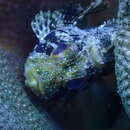ar
الأسماء في صفحات التنقل


Dendrochirus barberi és una espècie de peix pertanyent a la família dels escorpènids.[5]
És un peix marí, associat als esculls de corall i de clima tropical que viu entre 1-50 m de fondària.[6][8]
Es troba al Pacífic oriental central: les illes Hawaii i l'atol Johnston.[6][9][10]
És bentònic dins d'esquerdes i coves durant el dia i, de vegades, bentopelàgic a la nit entre 1-134 m de fondària.[11]
Dendrochirus barberi és una espècie de peix pertanyent a la família dels escorpènids.
Dendrochirus barberi, the Hawaiian lionfish or green lionfish, is a species of marine ray-finned fish belonging to the family Scorpaenidae, the scorpionfishes and lionfishes. It occurs in the Eastern Central Pacific. It occasionally makes its way into the aquarium trade.
Dendrochirus barberi Was first formally described in 1900 as Pterois barberi by the Austrian ichthyologist Franz Steindachner with the type locality given as between Honolulu and Cape Horn, although it was actually near the Hawaiian Islands.[3] This species is part of the brachypterus species complex within the genus Dendrochirus.[4] The specific name honours Captain Barber who caught the holotype among plankton on the voyage from Honolulu to Cape Horn in 1896-97, Steindachner gave no further information about Captain Barber.[5]
Dendrochirus barberi has 13 spines and 9 soft rays in its dorsal fin and 3 spines and 5 soft rays in its anal fin, the spines in the dorsal fin are more than half the depth of the body, separated by deeply notched membranes. It has a large pectoral fin in which the upper rays are branched towards their tips. There are coronal spines and large specimens may have some branches on the spines on the head. The suborbital ridge has a single row of spines and not a wide patch of minute spinules. The supraocular tentacle may be present and is short, with a length less than the diameter of the orbit and is typically absent.[2] The overall color of the head and body is orange-brown with many scattered, small white spots, whitish on the lower body. There are three poorly marked wide brownish bands on the head, the front band is below the eye. the middle band runs diagonally across the eye from the base of the supraocular spine to the interopercle and the rear band saddles the nape at the base pof the parietal spine. There are six indistinct brownish vertical bands on flanks, the 5 forward bands are underneath the dorsal fin base, and extend onto the fin membrane. The 2 bands over the anal fin extend onto its fin membrane and the rearmost band is on the caudal peduncle. All of these bands fade as the fish grows. The color of the eyes is orange-red with a black iris. The spiny part of the dorsal fin is whitish, with 2–4 irregular orange-brown bands on each spine and the soft-rayed part is semi-translucent marked with many small dark spots on the fin rays. The pectoral fin is also whitish marked with around 8 indistinct irregular brown bands and brownish mottles on its rear half. The pelvic fin is grayish-white marked with a few vague brown bands. The spiny part of the anal fin is also grayish-white and the soft-rayed part is semi-translucent like the soft rayed part of the dorsal fin and also has many small dark spots on each ray. The caudal fin is white and there are numerous small dark spots on its rays.[4] This species attains a maximum total length of 16.5 cm (6.5 in).[2]
Dendrochirus barberi is found in the eastern central Pacific where it is endemic to the Hawaiian Islands and Johnston Atoll.[1] It lives in waters of less than 50 m (160 ft) depth,[2] on coral or in rocky crevices,[6] in clear seaward reefs or in turbid lagoons.[2]
Dendrochirus berberi spends the day hiding in crevices and caves but appears to become benthopelagic during the night hours.[1] It feeds on small fishes and crustaceans.[7]
Dendrochirus barberi is infrequent in the aquarium trade,[7] specimens traded are wild caught.[6] The impact of catching these fishes to sell in the aquarium trade is not understood.[1]
Dendrochirus barberi, the Hawaiian lionfish or green lionfish, is a species of marine ray-finned fish belonging to the family Scorpaenidae, the scorpionfishes and lionfishes. It occurs in the Eastern Central Pacific. It occasionally makes its way into the aquarium trade.
El pez león de Hawái (Dendrochirus barberi) es una especie de pez león enano de la zona este del Océano Pacífico central. Ocasionalmente es comercializado para acuarios. Alcanza los 16 cm de longitud.
Se lo encuentra en el sector central del Océano Pacífico. Es un pez marino, asociado a los arrecifes de coral y de aguas tropicales que vive a profundidades entre 1 y 50 m.[1][2]
El pez león de Hawái (Dendrochirus barberi) es una especie de pez león enano de la zona este del Océano Pacífico central. Ocasionalmente es comercializado para acuarios. Alcanza los 16 cm de longitud.
Dendrochirus barberi Dendrochirus generoko animalia da. Arrainen barruko Scorpaenidae familian sailkatzen da.
Dendrochirus barberi Dendrochirus generoko animalia da. Arrainen barruko Scorpaenidae familian sailkatzen da.
Dendrochirus barberi is een straalvinnige vissensoort uit de familie van schorpioenvissen (Scorpaenidae).[1] De wetenschappelijke naam van de soort is voor het eerst geldig gepubliceerd in 1900 door Steindachner.
Bronnen, noten en/of referenties巴氏短鰭蓑鮋,為輻鰭魚綱鮋形目鮋亞目鮋科的其中一種,為熱帶海水魚,分布於中太平洋東部夏威夷群島海域,棲息深度1-50公尺,體長可達16.5公分,棲息在臨海礁石及潟湖,生活習性不明,具有毒性,可作為觀賞魚。
巴氏短鰭蓑鮋,為輻鰭魚綱鮋形目鮋亞目鮋科的其中一種,為熱帶海水魚,分布於中太平洋東部夏威夷群島海域,棲息深度1-50公尺,體長可達16.5公分,棲息在臨海礁石及潟湖,生活習性不明,具有毒性,可作為觀賞魚。